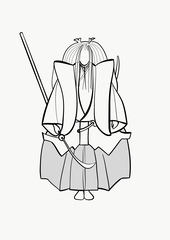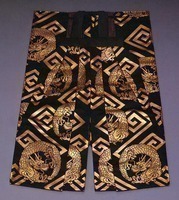Hangiri
はんぎり 半切
Hangiri pleated trousers are a hakama-style noh costume with woven patterning that are worn by strong male characters such as powerful deities, warriors, bandits, tengu, and vengeful ghosts.
Noh Kyogen
Roles and Draping
Before donning hangiri, the stiff back panels are given a deep tuck to form a mound or bulge. The actor steps into the leg openings, and then the front half of the trousers is secured in place by tying the attached belt sashes at the back. Next the stiff mounded back panels are slipped over a fork-shaped wooden prong inserted in the tied sashes. The broad back panels add bulk and majesty to the figure when combined with a happi (bandits, goblins) a sobatsugi or happi with the sleeves hiked up (strong warrior or revengeful ghost) and kariginu (stong deities such as the god Kamo Wakeikazuchi in the play Kamo.

Textile Features and Tailoring
The basic construction of hangiri is similar to that of ōkuchi, except that the attached sashes are a different cloth from the garment and that the entire garment is made of the same fabric, generally satin with supplementary patterning in gold or silver, or sometimes colored threads. To achieve the stiffness necessary for the back panels, reed mats are inserted as a core between the face fabric and lining.
Designs and Colors
Bold designs are common, often gold against a strong color like red, navy, purple, green, or white. Geometric patterns are common, though painterly motifs like large waves became common in the late Edo period.
 Hangiri with design of dragon rounds and lightning on a dark green ground. Produced by Akira Yamaguchi.
Hangiri with design of dragon rounds and lightning on a dark green ground. Produced by Akira Yamaguchi.
Contributor
Monica Bethe